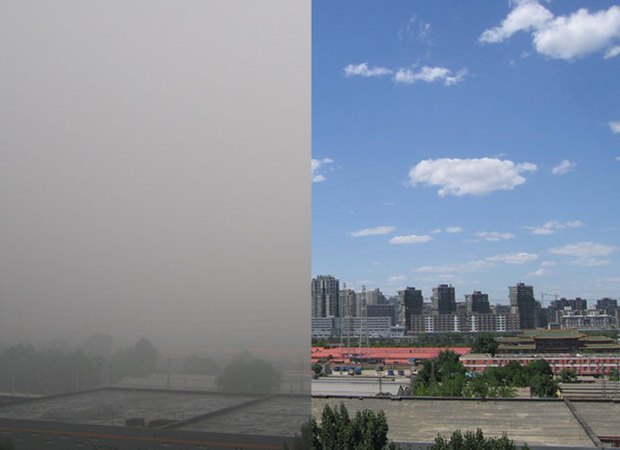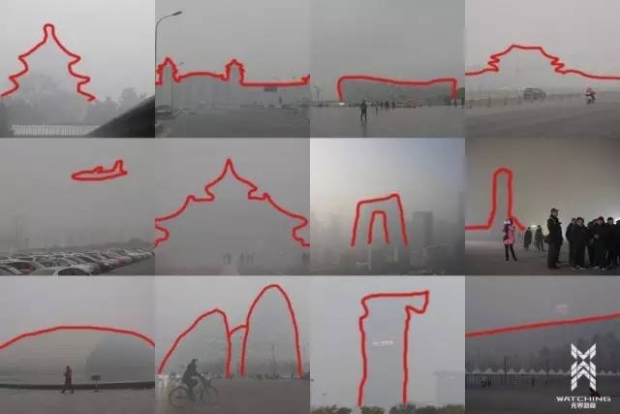The last few days of November, air pollution was back in the headlines and social media feeds of millions of Chinese. Here are a few highlights:
The creative WeChat post “Beijing Smog: Use Your Imagination When You Go Out,” shows a series of photos of smog-plagued Beijing, with all the visibly missing landmarks photoshopped in with a red outline—including the Temple of Heaven, the Bird’s Nest Olympic stadium, the Monument to the People’s Heroes in Tiananmen Square, the “Egg” (National Center for the Performing Arts), the CCTV Tower, and even an airplane.
A young man from Shenzhen nicknamed “Brother Nut” documented a performance art piece in which he roamed the streets of Beijing with a vacuum cleaner for 100 days. After sucking up dust from those smoggy months, he went to a brick kiln in Hebei and made a brick out of his collection.
In a Chinese-language post, Greenpeace criticized the government for not giving this smog run a red alert, which would mean advising schools to close so that kids stay at home, out of the hazardous air. The government has been criticized for failing to properly alert citizens of hazardous pollution levels on two other notable occasions in 2014, first from February 24-26, and then again from October 7-10. In both instances, Beijing toned down the alerts to orange instead of red. The response from Beijing’s Environmental Protection Bureau was that an orange alert already involves a lot of mandatory measures, such as shutting down construction and certain industrial activities, which would have quite an effect on pollution reduction. Compared with a red alert, which restricts almost half of the cars on the road and suspends schools, an orange alert causes less inconvenience to the lives of citizens.
In a collection by YeeMedia of personal, Chinese-language stories about how people have been dealing with persistent air pollution in Beijing, one man describes how he left the city which he had called home for 12 years and moved to Los Angeles, where he concluded that the U.S. is truly a “paradise for raising kids.” In his younger years, the air was “ok,” with occasional dust storms blowing in from the Gobi desert. Then the air pollution got worse and worse, and he credits a miscarriage his wife had to the health impact of the pollution.
In another good dose of humor, the following goofy poem made the rounds on WeChat, inspired by a poem by Chairman Mao that is familiar to most students in China:
Beijing scenery,
Hundreds of miles of haze,
Thousands of miles of floating dust,
In and out of the Third Ring Road,
Billows of thick fog,
Up and down the Bird’s Nest,
Waves of smog!
Cars snaking through traffic,
Smoke locks up runways,
Want to car race on the Sixth Ring Road,
Need to wait for a sunny day,
Inside and outside my car,
Clean it all up.
The air is so polluted,
It forced many pretty women to put on masks,
Pity that with a mask on,
[They] wasted all the makeup!
With only two eyes uncovered,
Cannot see their looks.
Once a landmark,
The Pants [CCTV] Tower,
You can only see its butt but not its waist.
With dust entering the lungs,
There are still death-defyers,
Who are still doing morning exercises [in the open air].
Finally, we dug up a video on air pollution that we produced with MediaStorm in 2008, shortly before the Beijing Summer Olympics. We find that this video is still relevant today, and that the problem of air pollution will probably persist throughout much of China for the foreseeable future.
Environment
01.23.15




